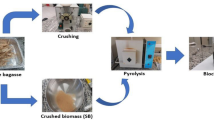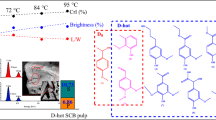Abstract
Using wet-storage pretreatment coupled with oxygen-alkali cooking technique can achieve the high efficiency, energy-saving and clean extraction of bagasse fibers. Based on this view, the delignification and carbohydrate degradation behaviors of wet-storage bagasse under different pulping conditions (cooking time, alkali charge, MgSO4 dosage, and initial pressure of oxygen) were investigated in detail. The results showed that the bagasse could form pulp after wet-storage pretreatment at a lower temperature (90 °C) and lower alkali charge (24%). In addition, the kinetic models of oxygen delignification and two-step degradation of carbohydrate (bulk fiber to individual fiber bundles, and then to degradable cellulose) were established to control the process of oxygen-alkali pulping. The activation energy for oxygen delignification and two-step degradation of carbohydrates was 31.45, 33.17 and 28.07 kJ/mol, respectively, indicating that the screened pulp fibers were more susceptible to degradation during oxygen delignification for bagasse after wet-storage. Therefore, the cooking end-point needs to be accurately controlled to reduce the significant degradation of carbohydrates in the later stage of cooking for oxygen alkali pulping of bagasse after wet-storage pretreatment.
Graphical abstract






Similar content being viewed by others
Data availability
The data that support the findings of this study are available from the corresponding author upon reasonable request.
References
Agarwal NK, Kumar M, Ghosh P, Kumar SS, Singh L, Vijay VK, Kumar V (2022) Anaerobic digestion of sugarcane bagasse for biogas production and digestate valorization. Chemosphere 295:133893. https://doi.org/10.1016/j.chemosphere.2022.133893
Akbar J, Iqbal MS, Massey S, Masih R (2012) Kinetics and mechanism of thermal degradation of pentose- and hexose-based carbohydrate polymers. Carbohyd Polym 90(3):1386–1393. https://doi.org/10.1016/j.carbpol.2012.07.008
Alokika A, Kumar A, Kumar V, Singh B (2021) Cellulosic and hemicellulosic fractions of sugarcane bagasse: potential, challenges and future perspective. Int J Biol Macromol 169:564–582. https://doi.org/10.1016/j.ijbiomac.2020.12.175
Ambye-Jensen M, Balzarotti R, Thomsen ST, Fonseca C, Kadar Z (2018) Combined ensiling and hydrothermal processing as efficient pretreatment of sugarcane bagasse for 2G bioethanol production. Biotechnol Biofuels 11:336. https://doi.org/10.1186/s13068-018-1338-y
Anupam K, Swaroop V, Lal PS (2018) Antagonistic, synergistic and interaction effects of process parameters during oxygen delignification of Melia dubia kraft pulp. J Clean Prod 199:420–430. https://doi.org/10.1016/j.jclepro.2018.07.125
Bering E, Torstensen JO, Lervik A, de Wijn AS (2022) Computational study of the dissolution of cellulose into single chains: the role of the solvent and agitation. Cellulose 29(3):1365–1380. https://doi.org/10.1007/s10570-021-04382-9
Bijok N, Fiskari J, Gustafson RR, Alopaeus V (2022) Modelling the kraft pulping process on a fiber scale by considering the intrinsic heterogeneous nature of the lignocellulosic feedstock. Chem Eng J 438:135548. https://doi.org/10.1016/j.cej.2022.135548
Dang VQ, Nguyen KL (2008) A universal kinetic model for characterization of the effect of chip thickness on kraft pulping. Bioresour Technol 99(5):1486–1490. https://doi.org/10.1016/j.biortech.2007.02.034
Freitas JV, Bilatto S, Squinca P, Pinto ASS, Brondi MG, Bondancia TJ, Batista G, Klaic R, Farinas CS (2021) Sugarcane biorefineries: potential opportunities towards shifting from wastes to products. Ind Crop Prod. https://doi.org/10.1016/j.indcrop.2021.114057
Han QQ, Gao X, Zhang H, Chen KL, Peng LC, Jia QM (2019) Preparation and comparative assessment of regenerated cellulose films from corn (Zea mays) stalk pulp fines in DMAc/LiCl solution. Carbohyd Polym 218:315–323. https://doi.org/10.1016/j.carbpol.2019.04.083
Hedjazi S, Kordsachia O, Patt R, Latibari AJ, Tschirner U (2008) Bagasse alkaline sulfite-anthraquione (AS/AQ) pulping and totally chlorine free (TCF) beaching. Holzforschung 62(2):142–148. https://doi.org/10.1515/hf.2008.044
Hu HC, Chai XS, Zhang CY, Fu LM, Barnes D, Huang LL, Chen LH (2015) Experimental data and kinetic models in terms of methanol formation during oxygen delignification processes of alkaline pulps. Holzforschung 69(8):933–942. https://doi.org/10.1515/hf-2014-0246
Jafari V, Nieminen K, Sixta H, van Heiningen A (2015) Delignification and cellulose degradation kinetics models for high lignin content softwood Kraft pulp during flow-through oxygen delignification. Cellulose 22(3):2055–2066. https://doi.org/10.1007/s10570-015-0593-3
Jafari V, Sixta H, van Heiningen A (2014) Kinetics of oxygen delignification of high-kappa pulp in a continuous flow-through reactor. Ind Eng Chem Res 53(20):8385–8394. https://doi.org/10.1021/ie403336x
Ji Y, Vanska E, van Heiningen A (2009) New kinetics and mechanisms of oxygen delignification observed in a continuous stirred tank reactor. Holzforschung 63(3):264–271. https://doi.org/10.1515/hf.2009.045
Kuitunen S, Kalliola A, Tarvo V, Tamminen T, Rovio S, Liitia T, Ohra-Aho T, Lehtimaa T, Vuorinen T, Alopaeus V (2011) Lignin oxidation mechanisms under oxygen delignification conditions. Part 3. Reaction pathways and modeling. Holzforschung 65(4):587–599. https://doi.org/10.1515/hf.2011.100
Kuitunen S, Tarvo V, Liitia T, Rovio S, Vuorinen T, Alopaeus V (2014) Modeling of alkaline extraction chemistry and kinetics of softwood kraft pulp. Holzforschung 68(7):733–746. https://doi.org/10.1515/hf-2013-0225
Lopez F, Diaz MJ, Eugenio ME, Ariza J, Rodriguez A, Jimenez L (2003) Optimization of hydrogen peroxide in totally chlorine free bleaching of cellulose pulp from olive tree residues. Bioresource Technol 87(3):255–261. https://doi.org/10.1016/s0960-8524(02)00239-0
Mamaye M, Kiflie Z, Feleke S, Yimam A (2022) Evaluation and optimization of kraft delignification and single stage hydrogen peroxide bleaching for ethiopian sugarcane bagasse. J Nat Fibers 19(4):1226–1238. https://doi.org/10.1080/15440478.2020.1764447
Miranda I, Pereira H (2002) Kinetics of asam and kraft pulping of eucalypt wood (eucalyptus globulus). Holzforschung 56(1):85–90. https://doi.org/10.1515/hf.2002.014
Nicholson DJ, Leavitt AT, Stromberg B, Francis RC (2017) Mechanistic differences between kraft and soda-AQ pulping of hardwoods with regard to lignin-carbohydrate complexes (LCC). J Wood Chem Technol 37(4):307–322. https://doi.org/10.1080/02773813.2017.1299184
Ochica Larrota AF, Vera-Graziano R, Lopez-Cordoba A, Gomez-Pachon EY (2021) Electrospun ultrafine cationic cellulose fibers produced from sugarcane bagasse for potential textile applications. Polymers. https://doi.org/10.3390/polym13223927
Oliveira SD, Padilha CED, Asevedo EA, Pimentel VC, de Araujo FR, de Macedo GR, dos Santos ES (2018) Utilization of agroindustrial residues for producing cellulases by aspergillus fumigatus on semi-solid fermentation. J Environ Chem Eng 6(1):937–944. https://doi.org/10.1016/j.jece.2017.12.038
Rainey TJ, O’Hara IM, Mann AP, Bakir CH, Plaza F (2013) Effect of depithing on the safety and environmental aspects of bagasse stockpiling. Process Saf Environ 91(5):378–385. https://doi.org/10.1016/j.psep.2012.09.002
Renders T, Van den Bossche G, Vangeel T, Van Aelst K, Sels B (2019) Reductive catalytic fractionation: state of the art of the lignin-first biorefinery. Curr Opin Biotech 56:193–201. https://doi.org/10.1016/j.copbio.2018.12.005
Salehi K, Kordsachia O, Patt R (2014) Comparison of MEA/AQ, soda and soda/AQ pulping of wheat and rye straw. Ind Crop Prod 52:603–610. https://doi.org/10.1016/j.indcrop.2013.11.014
Schoon NH (1982) Interpretation of rate-equations from kinetic-studies of wood pulping and bleaching. Sven Papperstidn 85(18):R185–R193
Sharma N, Godiyal RD, Thapliyal BP, Anupam K (2022) Insight into papermaking characteristics of D0EPD1-bleached soda, soda-AQ and kraft pulps of citronella grass (Cymbopogon winterianus Jowitt). Biomass Convers Bior 12(2):427–440. https://doi.org/10.1007/s13399-020-00730-0
Shuai L, Amiri MT, Questell-Santiago YM, Heroguel F, Li Y, Kim H, Meilan R, Chapple C, Ralph J, Luterbacher JS (2016) Formaldehyde stabilization facilitates lignin monomer production during biomass depolymerization. Science 354(6310):329–333. https://doi.org/10.1126/science.aaf7810
Sixta H, Promberger A, Koch G, Gradinger C, Messner K (2004) Influence of beech wood quality on bisulfite dissolving pulp manufacture. Part 1: influence of log storage on pulping and bleaching. Holzforschung 58(1):14–21. https://doi.org/10.1515/hf.2004.003
Sun B, Shan Y, Liu Y, Shang Z (2020) Enhanced delignification selectivity of alkali-oxygen pulping by wet-storage pretreatment with bleaching wastewater. BioResources 15(3):5281–5290. https://doi.org/10.15376/biores.15.3.5281-5290
Sun BL, Prates LL, Yu PQ (2019) Interactive curve-linear relationship between alteration of carbohydrate macromolecular structure traits in hulless barley (hordeum vulgare l.) grain and nutrient utilization, biodegradation, and bioavailability. Int J Mol Sci 20(6):1366. https://doi.org/10.3390/ijms20061366
Torgbo S, Quan VM, Sukyai P (2021) Cellulosic value-added products from sugarcane bagasse. Cellulose 28(9):5219–5240. https://doi.org/10.1007/s10570-021-03918-3
Van den Bosch S, Schutyser W, Vanholme R, Driessen T, Koelewijn SF, Renders T, De Meester B, Huijgen WJJ, Dehaen W, Courtin CM, Lagrain B, Boerjan W, Sels BF (2015) Reductive lignocellulose fractionation into soluble lignin-derived phenolic monomers and dimers and processable carbohydrate pulps. Energy Environ Sci 8(6):1748–1763. https://doi.org/10.1039/c5ee00204d
Xu HY, Chen KL, Zhang LL, Wu YL (2021) Synchronous silicon removal and viscosity reduction in the soda-oxygen pulping of wheat straw. Cellulose 28(14):9081–9089. https://doi.org/10.1007/s10570-021-04078-0
Yue F, Chen K-L, Lu F (2016a) Low temperature soda-oxygen pulping of bagasse. Molecules 21(1):85. https://doi.org/10.3390/molecules21010085
Yue FX, Lan W, Hu SN, Chen KL, Lu FC (2016b) Structural modifications of sugarcane bagasse lignins during wet-storage and soda-oxygen pulping. ACS Sustain Chem Eng 4(10):5311–5318. https://doi.org/10.1021/acssuschemeng.6b00726
Acknowledgments
This work is supported by the National Natural Science Foundation of China (Grant No. 21968014, 22008097), the National Key Research and Development Program of China (Grant No. 2019YFC1805904), the Scientific Research Fund of Yunnan Provincial Department of Education (Grant No. 2021J0051) and the Analysis and Testing Foundation of Kunming University of Science and Technology (No. 2019T20170031).
Author information
Authors and Affiliations
Corresponding authors
Ethics declarations
Conflict of interest
The authors have no conflicts of interest to declare that are relevant to the content of this article.
Ethical approval
This article does not contain any studies with human participants or animals performed by any of the authors. In this experiment, we did not collect any samples of humans and animals.
Informed consent
Informed consent was obtained from all individual participants included in the study.
Additional information
Publisher's Note
Springer Nature remains neutral with regard to jurisdictional claims in published maps and institutional affiliations.
Supplementary Information
Below is the link to the electronic supplementary material.
Rights and permissions
Springer Nature or its licensor holds exclusive rights to this article under a publishing agreement with the author(s) or other rightsholder(s); author self-archiving of the accepted manuscript version of this article is solely governed by the terms of such publishing agreement and applicable law.
About this article
Cite this article
Li, J., Miao, G., He, L. et al. Analyzing the delignification, carbohydrate degradation kinetics, and mechanism of wet-storage bagasse in oxygen-alkali cooking. Cellulose 29, 9421–9435 (2022). https://doi.org/10.1007/s10570-022-04843-9
Received:
Accepted:
Published:
Issue Date:
DOI: https://doi.org/10.1007/s10570-022-04843-9




